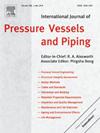A comprehensive comparison of creep-fatigue life assessment through leading industrial codes
IF 3
2区 工程技术
Q2 ENGINEERING, MECHANICAL
International Journal of Pressure Vessels and Piping
Pub Date : 2025-03-04
DOI:10.1016/j.ijpvp.2025.105497
引用次数: 0
Abstract
Creep-fatigue damage has been recognized as a critical failure mode for high-temperature structures. In fusion power reactors, plasma-facing components endure complex loading conditions, resulting in high thermomechanical stresses. These components, often made from 316L material, joined to ferritic-martensitic steels, face significant challenges due to the interaction of various loads affecting their material properties and structural integrity. This paper compares internationally recognized methods for creep-fatigue assessment: the R5 procedure and the RCC-MRx code.
The study evaluates the differences and similarities in creep-fatigue assessments between these procedures, providing a global overview and a detailed comparison. The conservatism of both approaches are assessed by comparing the material properties dataset, total strain calculations, and lifetime estimates for 316L at 550 °C. Additionally, the welding assessment approaches of RCC-MRx and R5 are compared and applied to similar metal welds (316L-to-316L). Further, dissimilar Electron Beam Welded metals (316L-to-10CrMo9-10) are prepared, investigated and characterized using creep-fatigue experiments to compare the predicted service life using RCC-MRx.
主要行业规范蠕变疲劳寿命评估的综合比较
蠕变疲劳损伤是高温结构的一种重要破坏模式。在核聚变反应堆中,面对等离子体的部件承受复杂的载荷条件,导致高的热机械应力。这些部件通常由316L材料制成,与铁素体-马氏体钢连接,由于各种载荷的相互作用会影响其材料性能和结构完整性,因此面临重大挑战。本文比较了国际公认的蠕变疲劳评估方法:R5程序和RCC-MRx规范。该研究评估了这些程序之间蠕变疲劳评估的异同,提供了一个全面的概述和详细的比较。通过比较材料性能数据集、总应变计算和316L在550°C下的寿命估算,评估了这两种方法的保守性。此外,比较了RCC-MRx和R5的焊接评估方法,并将其应用于类似的金属焊缝(316l - 316l)。此外,制备了不同类型的电子束焊接金属(316l - 10crmo9 -10),利用蠕变疲劳实验对其进行了研究和表征,并使用RCC-MRx对其预测使用寿命进行了比较。
本文章由计算机程序翻译,如有差异,请以英文原文为准。
求助全文
约1分钟内获得全文
求助全文
来源期刊
CiteScore
5.30
自引率
13.30%
发文量
208
审稿时长
17 months
期刊介绍:
Pressure vessel engineering technology is of importance in many branches of industry. This journal publishes the latest research results and related information on all its associated aspects, with particular emphasis on the structural integrity assessment, maintenance and life extension of pressurised process engineering plants.
The anticipated coverage of the International Journal of Pressure Vessels and Piping ranges from simple mass-produced pressure vessels to large custom-built vessels and tanks. Pressure vessels technology is a developing field, and contributions on the following topics will therefore be welcome:
• Pressure vessel engineering
• Structural integrity assessment
• Design methods
• Codes and standards
• Fabrication and welding
• Materials properties requirements
• Inspection and quality management
• Maintenance and life extension
• Ageing and environmental effects
• Life management
Of particular importance are papers covering aspects of significant practical application which could lead to major improvements in economy, reliability and useful life. While most accepted papers represent the results of original applied research, critical reviews of topical interest by world-leading experts will also appear from time to time.
International Journal of Pressure Vessels and Piping is indispensable reading for engineering professionals involved in the energy, petrochemicals, process plant, transport, aerospace and related industries; for manufacturers of pressure vessels and ancillary equipment; and for academics pursuing research in these areas.

 求助内容:
求助内容: 应助结果提醒方式:
应助结果提醒方式:


